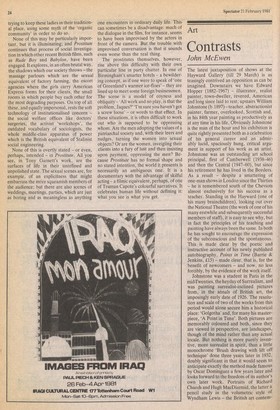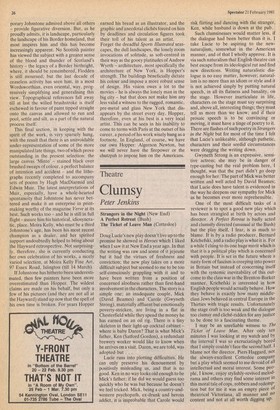Art
Contrasts
John McEwen
The latest juxtaposition of shows at the Hayward Gallery (till 29 March) is as teasingly contrived an opposition as can be imagined. Downstairs we have Edward Hopper (1882-1967) — illustrator, realist painter, town-dweller, revered, American and long since laid to rest; upstairs William Johnstone (b.1897)— teacher, abstractionist painter, farmer, overlooked, Scottish and, in his 84th year painting as productively as at any time in his life. Obviously Johnstone is the man of the hour and his exhibition is quite rightly presented both as a celebration of his general career and an admirably lucid, spaciously hung, critical argument in support of his work as an artist. Johnstone was an outstanding art school principal, first of Camberwell (1938-46) and then the Central (1947-60), but since his retirement he has lived in the Borders. As a result — despite a smattering of one-man shows in London since the Thirties — he is remembered south of the Cheviots almost exclusively for his success as a teacher. Standing in the Hayward (one of his many brainchildren), looking out over the National Theatre (the work of one of his many erstwhile and subsequently successful members of staff), it is easy to see why, but in fact the principles of his teaching and painting have always been the same. In both he has sought to encourage the expression of the subconscious and the spontaneous. This is made clear by the poetic and instructive account of his newly published autobiography, Points in Time (Barrie 84 Jenkins, E15) — made clear, that is, for the benefit of newcomers — and now, no less forcibly, by the evidence of the work itself.
Johnstone was a student in Paris in the mid-Twenties, the heyday of Surrealism, and was painting surrealist-inclined pictures from, in the annals of British art, the imposingly early date of 1926. The resolution and scale of two of the works from this period would alone secure him a historical place: 'Golgotha' and, for many his masterpiece, 'A Point in Time'. Both pictures are memorably cWoured and both, since they are viewed in perspective, are landscapes, though of the mind rather than any actual locale. But nothing is more purely inventive, more surrealist in spirit, than a little monochrome 'Brush drawing with lift off technique' done three years later in 1932, doubly significant in that it would seem to anticipate exactly the method made famous by Oscar Dominguez a few years later and looks forward to the freedom of its author's own later work. Portraits of Richard Church and Hugh MacDiarmid, the latter a pencil study in the volumetric style of Wyndham Lewis — the British art contem porary Johnstone admired above all others — provide figurative diversion. But, as he proudly admits, it is landscape, particularly the landscape of his Border homeland, that most inspires him and this has become increasingly apparent, No Scottish painter has viewed the subject with a greater sense of the blood and thunder of Scotland's history — the legacy of a Border birthright, where, it should be remembered, Flodden is still mourned; but the last decade of ceaseless activity has seen him, in a most Wordsworthian , even oriental, way, progressively simplifying and generalising this view. Topographical references fall away till at last the willed brushstroke is itself eschewed in favour of paint tipped straight onto the canvas and allowed to run and pool, settle and silt, as a part of the natural process itself.
This final section, in keeping with the spirit of the work, is very sparsely hung, with the result that there is an unavoidable under-representation of some of the more manipulated late things, two of which prove outstanding in the present selection: the large canvas `Minto' — stained black over brushed sweeps of colour, a perfect balance of intention and accident — and the lithographs recently completed to accompany sets of poems by Hugh MacDiarmid and Edwin Muir. The latest interpretations of Muir, especially, have a whole-hearted spontaneity that Johnstone has never bettered and make it an enterprise in printmaking worthy of the magazine Verve at its best. Such works too — and he is still in full flight — assure him his historical, idiosyncratic, place. Moira Kelly, who must be a third Johnstone's age, has been his most recent champion as a dealer, and her spirited support undoubtedly helped to bring about the Hayward retrospective. Not surprisingly, therefore, she is currently conducting her own celebration of his works, a nicely, varied selection. at Moira Kelly Fine Art, 97 Essex Road, Islington (till 14 March).
If Johnstone has hitherto been underestimated, then few painters have been more overestimated than Hopper. The wildest claims are made on his behalf, but only a few of his pictures (and they are not all at the Hayward) stand up now that the spell of his own time is broken. For years Hopper earned his bread as an illustrator, and the graphic and anecdotal clichés forced on him by deadlines and circulation figures took their toll of his talent as an artist.
Forget the dreadful Sports Illustrated seascapes, the dull landscapes, the lonely room invocations of solitude, as soft-centred in their way as the gooey platitudes of Andrew Wyeth — architecture, most specifically the architecture of New York, is Hopper's strength. The buildings beneficially dictate his colour and impose a more robust sense of design. His vision owes a lot to the movies — he is always the lonely man in the big city — but that does not make him any less valid a witness to the rugged, romantic, pre-metal and glass New York that disappears by the street every day. Hopper, therefore, even at his best is a very local artist. This can be seen in his inability to come to terms with Paris at the outset of his career, a period of his work wisely hung as a footnote. In England, of course, we have our own Hopper: Algernon Newton, but we will never have the firepower or the chutzpah to impose him on the Americans.







































 Previous page
Previous page